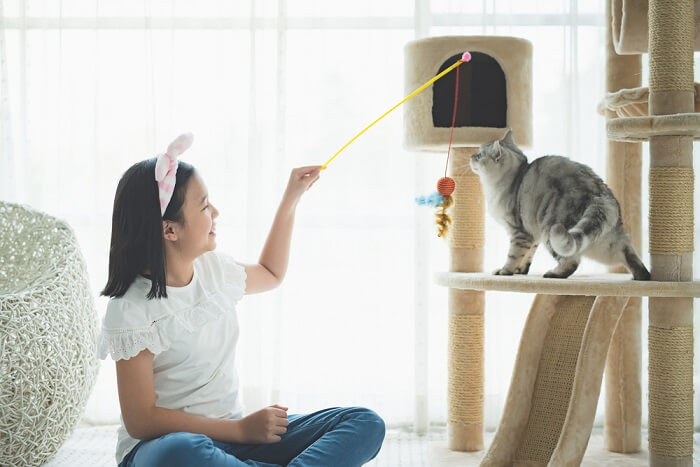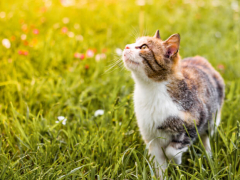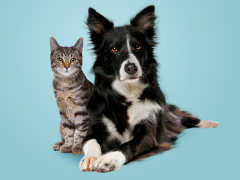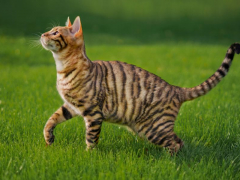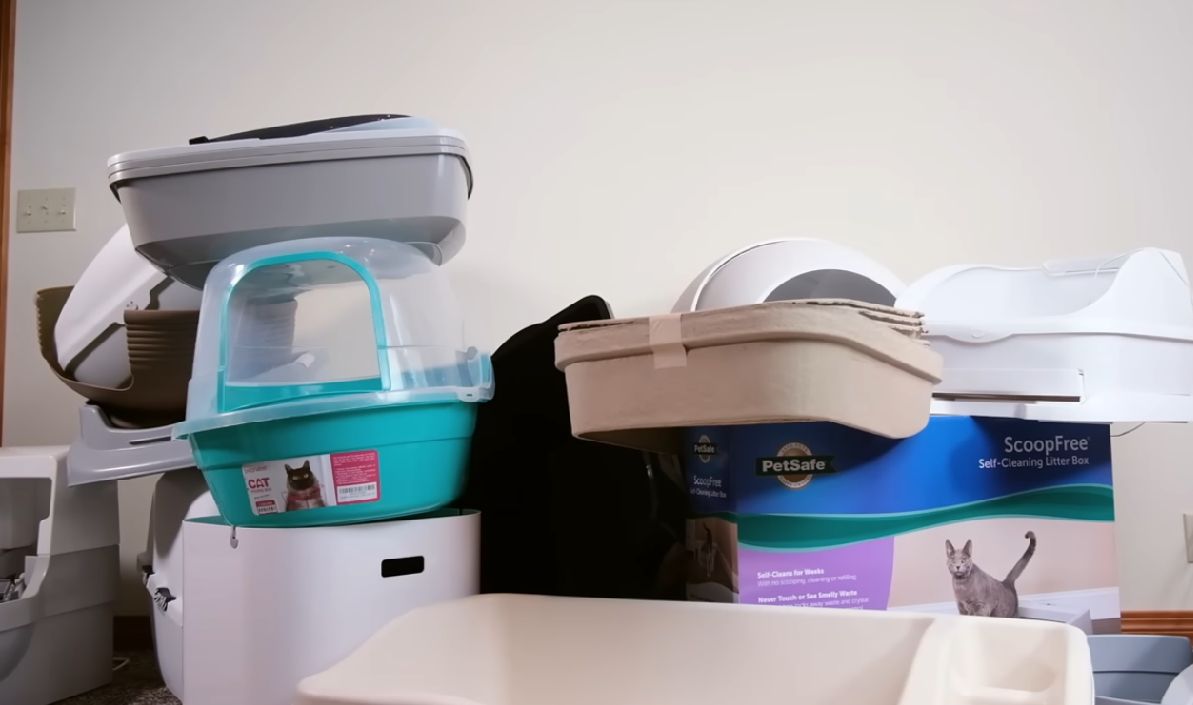
Mallory Crusta / Cats.com
Are you ready to find the perfect litter box for your cat? With so many options available, choosing the best litter box can feel overwhelming. Whether you’re a first-time cat parent or looking to upgrade your current setup, it helps to know what’s out there.
From the simplicity of traditional open pans to the convenience of automatic models, each option has its own pros and cons. Drawing from years of experience with cats and insights from two cat behavior experts, we’re here to make sense of your options.
In this guide, we’ll walk you through the main types of cat litter boxes, highlighting their key features and who’s likely to be a good fit. Here’s everything you should know to make an informed decision.
11 Types of Litter Boxes—And How to Choose
Choosing the right cat litter box is an important decision for any cat parent, and it often requires a bit of trial and error. Mallory Crusta breaks down some key considerations for us in the following video.
1. Open Litter Pan
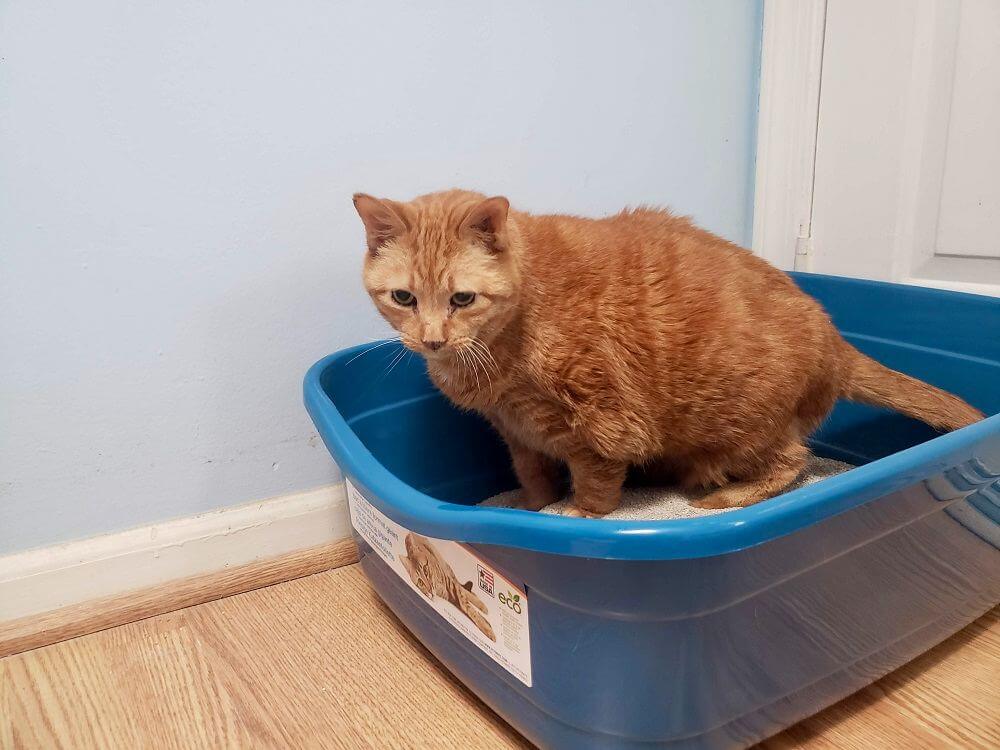
Open litter pans allow cats to scan their surroundings, helping them feel safe and secure during a vulnerable time. Liz Coleman / Cats.com
Open litter boxes are a simple and effective option for most cats. With a straightforward tray design and no lid, they offer easy access and visibility, helping cats feel secure while doing their business.
When choosing a size, opt for the largest box that fits your space and budget, as more room is generally better for cats. Keep height in mind, as well; tall sides help contain litter but can be difficult for some cats to jump over. Lower sides are more manageable for seniors and less agile cats, but the tradeoff is a messier area.
Most open litter pans are made from plastic, which makes them affordable and easy to clean. There are also stainless steel boxes, which are durable and more hygienic.
Advantages
- Accessible: Cats can enter and exit freely without navigating a lid or flap.
- Visibility: Cats can scan their surroundings, which makes them feel safe during a vulnerable time.
- Simplicity: Open litter boxes are easy to use and require no assembly. Just fill them with litter, and you’re all set!
- Hassle-free maintenance: Scooping is quick and easy since there’s no lid to remove.
- Budget-friendly: Open litter pans are generally inexpensive and widely available in-store and online.
Drawbacks to consider
- Poor odor control: Without a cover to contain unpleasant smells, odors tend to linger. (Pro tip: you can mitigate some of the stink using a good litter that forms tight, solid clumps.)
- Messier: The open design can lead to more scatter in the surrounding area. Additionally, if your cat is a sprayer, an open pan won’t protect against errant streams of urine.
- Limited privacy: While most cats prefer an unhindered view, some prefer a more secluded space for their bathroom needs. This could deter shy or anxious cats.
Open litter boxes are best suited for:
- Multi-cat households: Open pans benefit homes with several felines because they’re simple to scoop, clean, and maintain.
- Cat parents seeking simplicity: If you’re looking for a basic, no-frills option, an open litter box is the way to go. They’re ideal for busy households where quick clean-up is essential.
2. High-Sided Litter Box
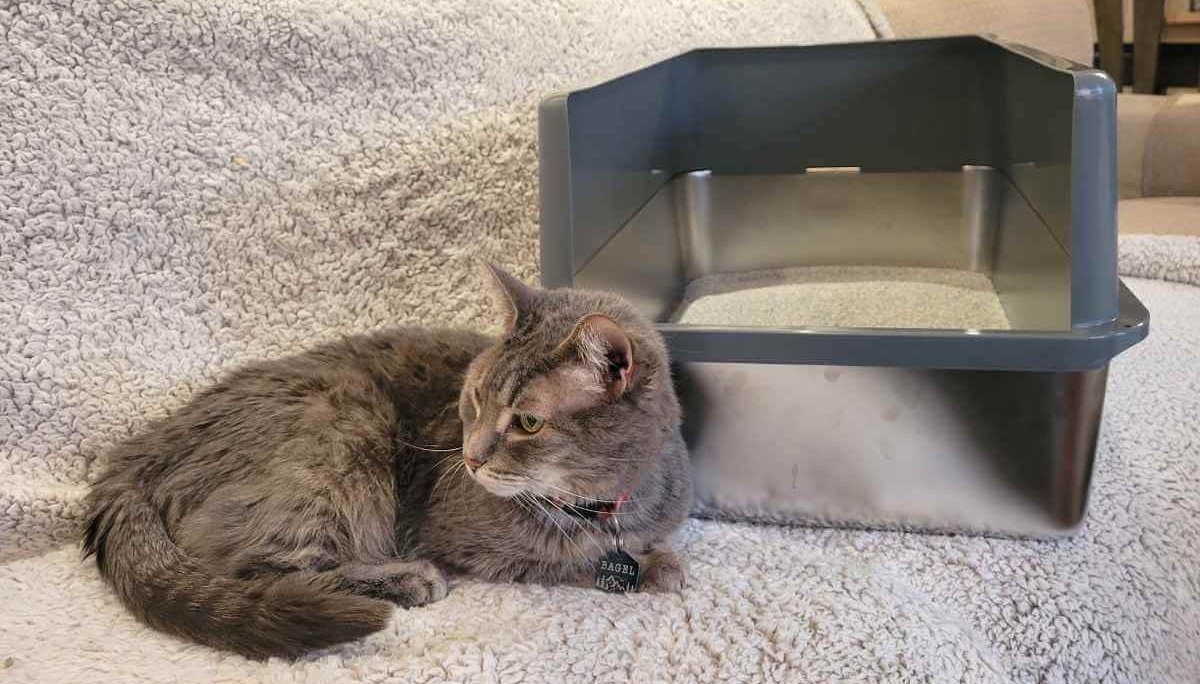
The iPrimio High-Sided Litter Box allows your cat to bury their waste without spilling litter over the edge. Kate Barrington / Cats.com
If your cat tends to fling litter outside their box, a high-sided litter box could be the solution.
These boxes feature taller walls that effectively contain litter scatter and urine. Some models are designed as a single solid structure; others, like the iPrimio, include an attachable hood that adds extra height.
The open-top design allows easy access for most cats. However, cats with mobility issues may struggle with the higher walls. To accommodate these cats, look for models with three raised sides and a lower entry point (though this will compromise the scatter control somewhat).
Advantages
- Minimized mess: Higher sides keep litter in the box and off your floor.
- Freedom to dig: A high-sided box lets enthusiastic diggers bury their waste without sending litter over the edge.
Drawbacks to consider
- Accessibility concerns: While the higher walls excel in controlling mess, they can pose challenges for kittens, elderly cats, or those with limited mobility. Opt for models with a lower entryway if accessibility is a concern.
High-sided litter boxes are best suited for:
- Messy cats: Ideal for cats that kick litter out of the box or urinate over the sides.
3. Low-Entry Litter Box
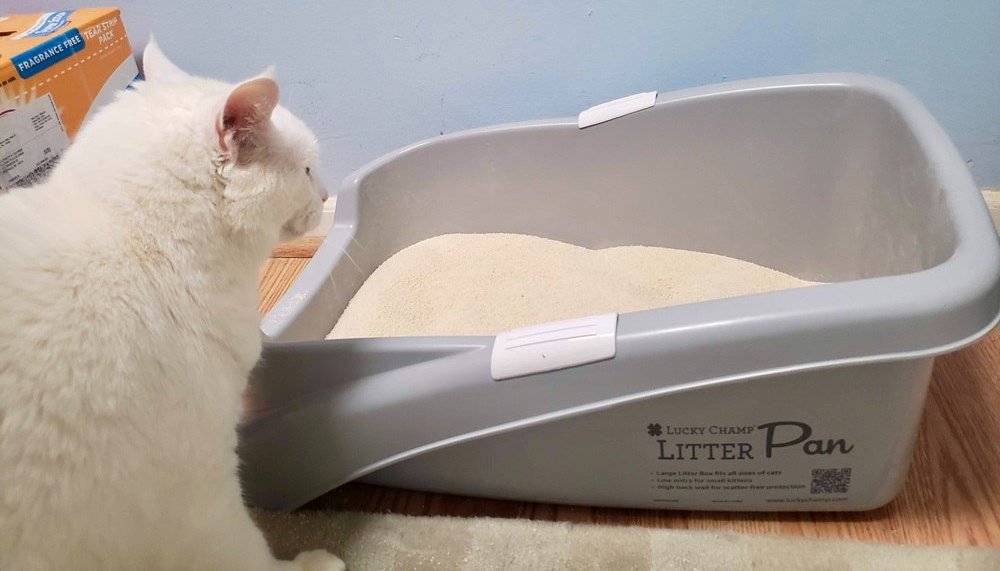
The Lucky Champ Low-Entry Litter Box is perfect for cats with arthritis or limited mobility, allowing them to step in and out with ease. Liz Coleman / Cats.com
Low-entry litter boxes have wide, low entryways, making them a good match for cats with mobility issues. These boxes provide easy access for senior cats, kittens, and any cat struggling with the height of traditional boxes. We tested the low-entry Lucky Champ with an unsteady senior cat and found the lower entrance made a big difference.
Alternatively, you could take a DIY approach. Susan Nilson, a cat and dog behavior consultant and founder of The Cat and Dog House, suggests modifying a standard box by cutting out a rectangular entrance that’s wide and low.
Advantages
- Accessible: Cats with arthritis or limited mobility can easily step in and out.
Drawbacks to consider
- Poor litter containment: The absence of tall sides means increased litter scatter and potential mess.
- Poor urine containment: Cats who tend to spray may not be the best candidates for a low-entry box.
Low-entry litter boxes are best suited for:
- Cats with limited mobility: This might include seniors, arthritic cats, tripods, or cats with chronic pain.
- Kittens: A low entrance is more accessible to tiny kittens still learning the ropes.
- Cat recovering from an injury: Low-entry boxes make it easier for cats to use the bathroom while they heal.
4. Sifting Litter Box
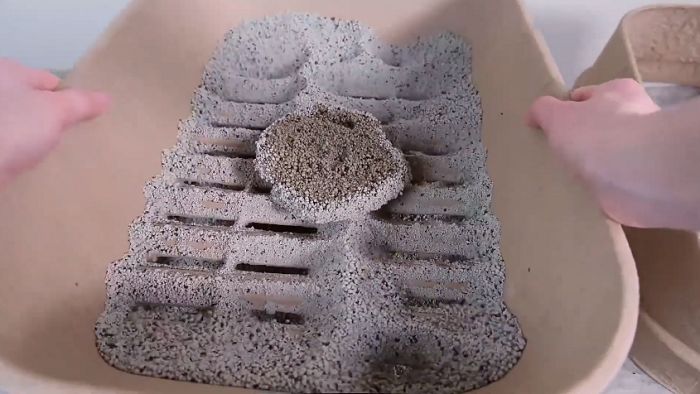
The Kitty Sift Litter Box features a sifting design that eliminates the need for scooping, making cleaning faster and more efficient. Mallory Crusta / Cats.com
Sifting boxes are designed to simplify the cleaning process by separating waste from clean litter. Typically, they consist of three trays: one slotted tray positioned between two solid trays.
Instead of scooping, you’ll lift the top tray and dump it into the sifting tray. Then, carefully sift the clean litter into the solid tray below, and voilà—you’ve got a pile of clumps that can get tossed in the trash.
These systems come in various styles (i.e., open, high-sided, & covered) and cater to different feline preferences. Some are even disposable, like the Kitty Sift Litter Box.
Advantages
- Easier cleaning: The sifting design eliminates the need for scooping, making litter box cleaning faster and more streamlined.
- Saves litter: These boxes can reduce litter waste and save you money in the long run.
Drawbacks to consider
- Can be heavy: Once it’s filled with litter, the slotted tray may become heavy and difficult to lift.
- Difficult to deep clean: Achieving a thorough clean can be fiddly since litter pieces can get stuck in the slots.
- Litter limitations: These boxes work best with clumping litter, which won’t be everyone’s preference.
Sifting litter boxes might be a good fit for:
- Busy households: Perfect for those juggling a packed schedule and still wanting a tidy home.
- Folks who struggle with scooping: A practical option for individuals facing physical challenges that make constant scooping difficult.
5. Covered Litter Box
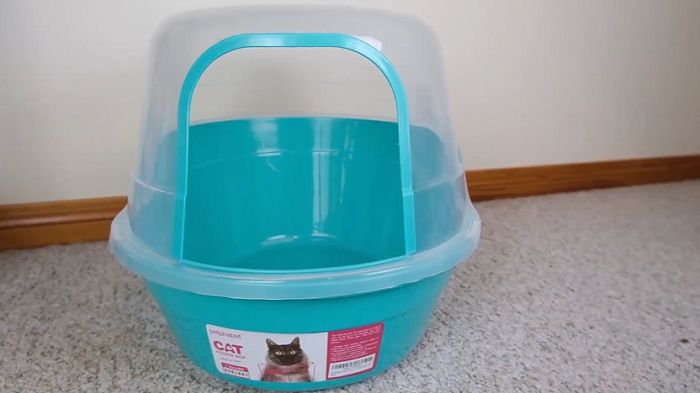
The Petphabet Covered Litter Box offers cats a secure, private space for their litter needs, providing comfort and seclusion. Mallory Crusta / Cats.com
If your litter box is in a prominent area of the home, or you’re just tired of endless smells and scatter, a covered box can help.
Covered litter boxes (aka hooded or enclosed boxes) offer cats privacy while containing messes and odors. Typically, these boxes have high walls and a removable hood with an open entrance, allowing cats to come and go as they please. Some models feature doors or flaps in the entryway.
While these boxes can be a huge help for pet parents, you’ll also want to consider your cat’s preferences.
“Research shows cats don’t necessarily mind covered boxes, as long as they’re kept clean,” says Nilson. Even so, not every cat will take to a covered box. Nilson adds that many cats will feel confined in a covered box and prefer a more open option. If you’re looking for a middle ground, consider a model with a transparent cover, like the Petphabet Covered Litter Box.
Advantages
- Odor control: The cover prevents unpleasant odors from wafting through your home.
- Minimizes litter scatter: A covered box is more effective at containing messes than an open tray.
- Keeps dogs (and children) out: Covered boxes deter curious dogs and tots from sampling your cat’s little treasures.
- Privacy: Some cats feel secure using a covered box and appreciate the secluded space.
Drawbacks to consider
- Limited visibility: While some cats feel safer in a covered box, many prefer to scan their surroundings.
- Single entry point: A box with only one exit may make some cats uneasy, as they could feel cornered.
- Stinky for cats: Although it keeps your home smelling fresh, an enclosed box can trap odors inside and make the experience uncomfortable for your cat.
- Trickier to scoop: The lid on some models may interfere with easy scooping.
Covered litter boxes are best suited for:
- Cats who prefer privacy: Perfect for cats who feel anxious in open spaces and prefer solitude while doing their business.
- Multi-pet households: A covered box helps keep out curious dogs or little ones.
6. Top-Entry Litter Box
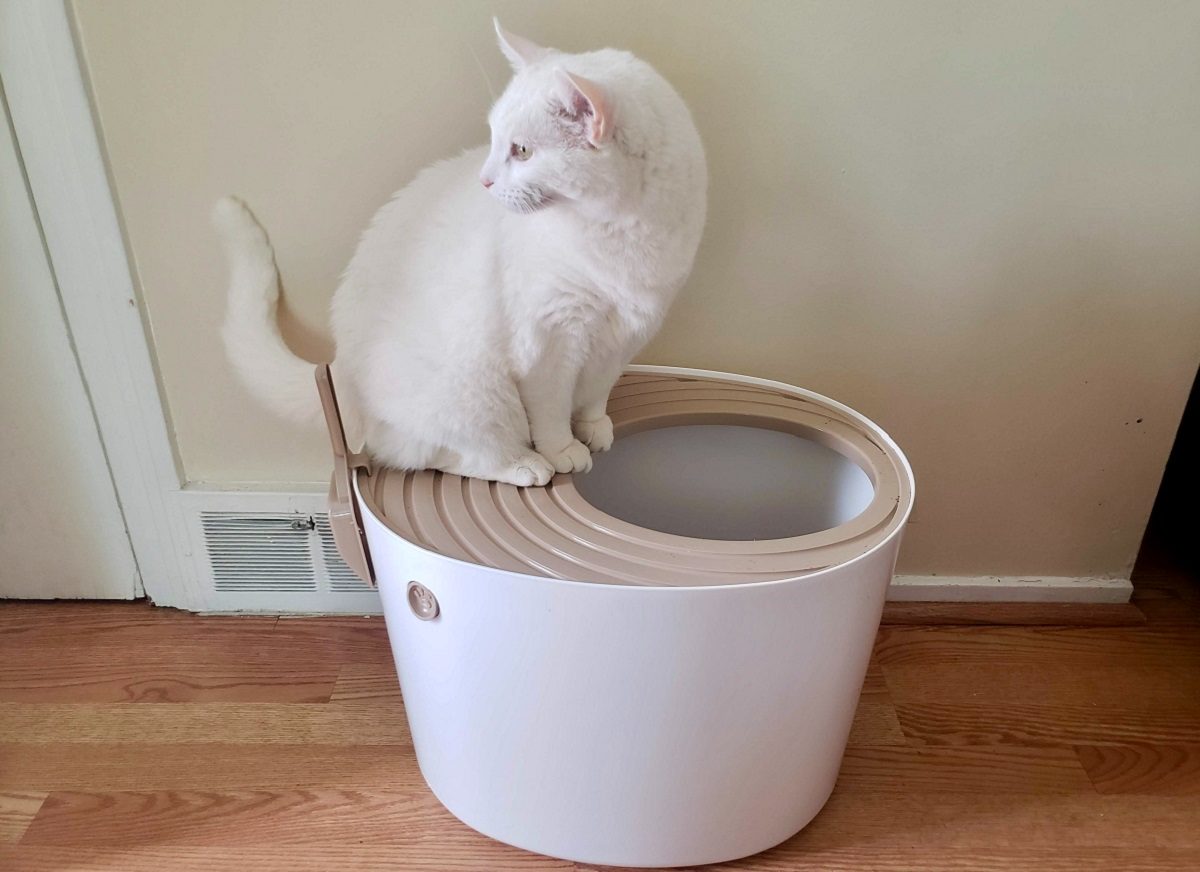
The IRIS Round Top-Entry Litter Box features an enclosed design that helps contain odors, keeping your living space fresh and clean. Liz Coleman / Cats.com
Like covered litter boxes, top-entry boxes help contain litter and odors. The main difference is how cats access the litter: cats enter a top-entry box through a lid that can also be removed for easy cleaning.
Notable models like the IRIS Round Top-Entry and ModKat Top-Entry feature ridged or grated lids that catch stray litter before it hits the ground. This design is beneficial for messy cats who kick litter everywhere. It also prevents curious dogs from sneaking a snack.
“Just ensure the setup still feels accessible and safe for the cat,” advises Cristy Brusoe, a certified cat trainer with Cat Training by Cristy.
Advantages
- Minimizes mess: Designed to keep litter inside, top-entry boxes reduce tracking and make cleaning the litter area
- Odor control: The enclosed design helps contain odors and keep your living space fresh.
- Discreet: A top-entry design keeps litter hidden from view, giving your home a tidy appearance.
- (Mostly) pet-proof: Like covered boxes, this design prevents inquisitive dogs or kids from accessing the litter.
- Private for shy cats: Some cats appreciate the comfort of an enclosed space.
Drawbacks to consider
- Accessibility issues: Cats with mobility challenges, including seniors, may struggle climbing or jumping into a top-entry box. Additionally, the small entry could pose problems for larger cats.
- Small interior space: Top-entry litter boxes are usually compact, which can make larger cats feel cramped and unable to move freely.
- Limited visibility: The enclosed design may cause some cats to feel insecure since they can’t scan their surroundings.
- Can be stinky for cats: The enclosed design benefits our human noses but could be tough on cats during use.
- Out of sight, out of mind: While litter remains hidden from guests, it can lead to forgetfulness in regular scooping.
Top-entry litter boxes are best suited for:
- Messy cats: Ideal for cats who kick litter out of their box.
- Agile cats: These boxes are best for cats who can jump and navigate in tight spaces.
- Households with dogs or young children: This design acts as a barrier to deter housemates who might be tempted by the litter.
7. Corner Litter Box
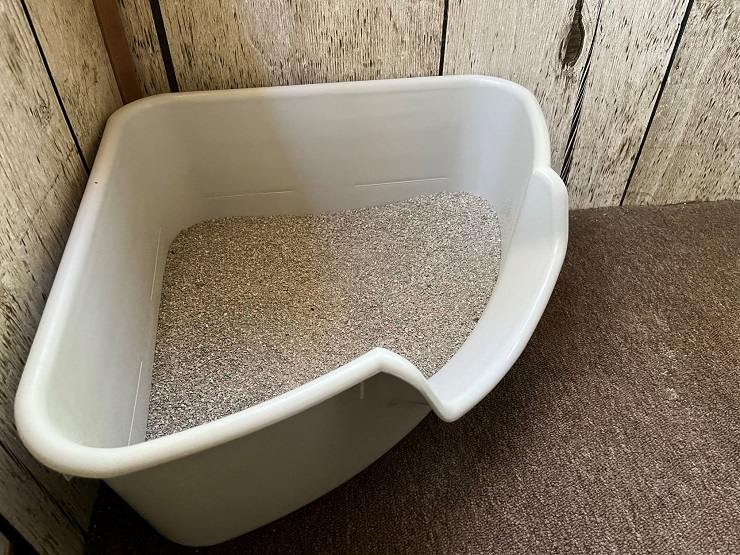
The SmartCat Corner Litter Box is perfect for small apartments or tight spaces, maximizing your available area while keeping your cat’s litter needs covered. Ma’ayan Gutbezahl / Cats.com
When space is limited, corner litter boxes can provide an effective solution. These boxes are designed to fit snugly into the corners of your home, making the most of smaller areas. Some corner litter boxes feature a hood, while others, like the SmartCat Corner Litter Box, have an open design.
Advantages
- Space efficient: Ideal for small apartments or tight spaces.
Drawbacks to consider
- Tight squeeze for big cats: Corner litter boxes are often smaller than traditional boxes, which may not fit larger cats who need more room to move around.
- Limited access: Cats can only enter from one side. The lack of an alternative exit could make some cats uneasy.
- Frequent cleaning needed: A smaller size means waste can accumulate quickly. You may need to scoop more often.
Corner litter boxes are best suited for:
- Households with limited space: Optimizes space in smaller living quarters.
- Small cats and kittens: These boxes accommodate petite or average-sized felines.
8. Self-Cleaning Automatic Litter Box
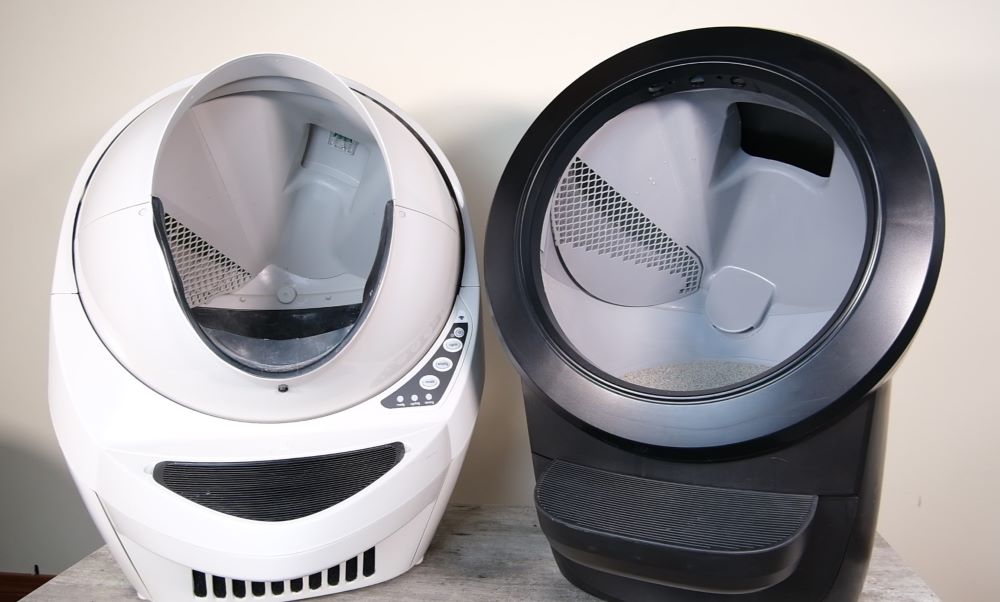
The Litter-Robot Self-Cleaning Automatic Litter Box features automated waste removal, saving you time and effort. Mallory Crusta / Cats.com
Self-cleaning litter boxes can be a game-changer for some cat guardians. Equipped with sensors, these automated devices sift or rake soiled litter after your cat exits. Waste is collected in a separate compartment.
This means less work for you and consistently clean space for your cat.
Automatic litter boxes come in several designs. The most popular are rotating globe-style models, like the Litter-Robot. You’ll also find sleek rectangular models like PetSnowy’s SNOW+ and simple raking mechanisms like the PetSafe ScoopFree. Some models even connect to your home’s water line for self-flushing capabilities, like the CatGenie.
Many self-cleaning litter boxes pair with an app, allowing you to track essential details like litter box usage and your cat’s weight.
However, Nilson encourages cat parents to consider their pet’s preferences before making such a significant investment. “While a self-cleaning litter box may be convenient for busy cat owners, your cat may not be of the same opinion,” she explains.
Advantages
- No more scooping: Automated waste removal saves time, letting you enjoy more moments with your cat. Perfect for busy cat parents who may overlook cleaning for a day or two.
- Maintains a clean home: As our experts point out, most cats prefer a clean litter box. An automated system helps maintain a spotless litter area.
- Better odor control: By removing waste immediately, these boxes minimize bad smells. The enclosed waste drawer also contains odors, and many models have built-in deodorizers.
- Practical for people with physical limitations: Ideal for seniors or anyone with difficulty bending down to scoop daily.
Drawbacks to consider
- Pricey investment: Self-cleaning litter boxes cost significantly more than traditional options.
- Large footprint: They take up a lot of space.
- Placement limitations: These units need to be located near a power outlet.
- Litter limitations: Most automatic litter boxes only function with clumping litter.
- Possible technological glitches: Like all technology, these devices can malfunction.
- Not all cats approve: Some cats may find the noise or mechanics intimidating. Others may dislike the covered design. Consider their temperament and past behavior if you’re unsure how your cat will react. Cats typically open to new things can be persuaded to use an automatic litter box with training and positive reinforcement.
- Not safe for tiny kittens: Most manufacturers advise against using an automatic litter box with young kittens.
Self-cleaning litter boxes are best suited for:
- Busy households: A self-cleaning litter box will streamline your routine if you’re too busy to scoop regularly.
- Individuals with limited mobility: Folks who find it difficult to bend down and scoop waste daily will appreciate the convenience of a machine that does the work for them.
- Adventurous cats: If your cat enjoys trying new things, they may adapt well to a self-cleaning model.
9. Disposable Litter Box
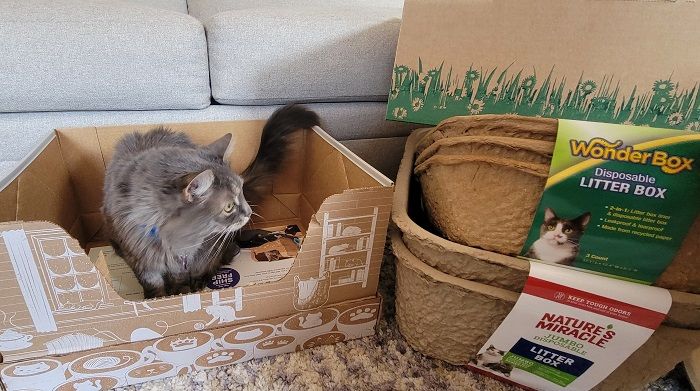
Disposable litter boxes offer ultimate convenience, making them ideal for trips or temporary living situations. Kate Barrington / Cats.com
Disposable litter boxes prioritize convenience and simplicity. They’re often made from materials like recycled cardboard or biodegradable paper. Instead of tediously scrubbing and rinsing, you can just toss them out once they’ve served their purpose.
Many models come pre-filled with litter, while others can be used with your preferred type. Typically, they are lightweight and smaller than standard boxes.
“Disposable litter boxes are great for travel, temporary housing situations, or when a cat is recovering from an illness,” says Brusoe.
Advantages
- Easy cleanup: The primary appeal is convenience. When it’s time to change the litter, just throw the entire box away—no scrubbing required.
- Travel-friendly: Ideal for trips or temporary living situations, these lightweight boxes can provide comfort without the bulk of a traditional litter box.
Drawbacks to consider
- Less durable: While convenient, disposable litter boxes are often less resilient than standard ones and can be prone to leaks.
- Odor control issues: The porous materials may trap odors.
- Requires frequent replacement: Unlike traditional litter boxes, these need regular replacement, which can add up in costs over time.
- Smaller size: These boxes tend to be smaller than regular litter boxes and may not accommodate larger cats.
Disposable litter boxes are best suited for:
- Travel: As a temporary solution for trips, disposable litter boxes are hard to beat.
- Cats in transition: Disposable litter boxes are a practical choice for temporary litter box needs (e.g., cats recovering from an illness or those moving to a new home)
10. Travel Litter Box
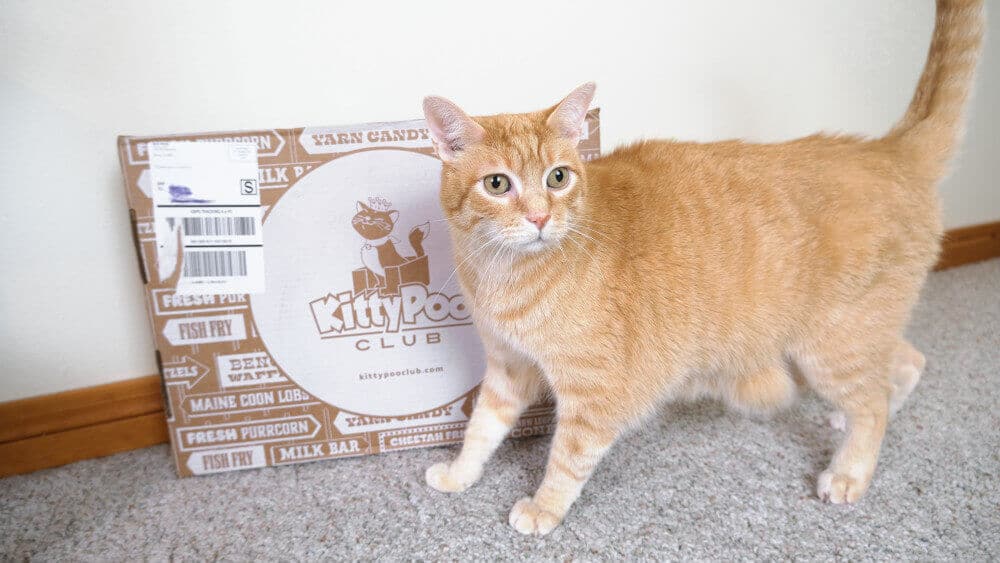
Travel Litter Box is designed for easy use and disposal, making it perfect for long journeys. Mallory Crusta / Cats.com
If you plan a trip with your cat, they’ll need a spot to relieve themselves. Lightweight, compact, and often foldable, travel litter boxes are designed for hassle-free transport.
Materials range from durable fabric to disposable cardboard options. Some have zippered covers to contain any mess during the journey.
Advantages
- Portable: A collapsible design allows for easy storage and transportation, making these boxes ideal for trips or moves.
- Disposable options available: Some designs can be used and discarded, which is convenient for long journeys.
Drawbacks to consider
- Size limitations: These boxes are usually smaller than standard litter boxes.
- May require a liner: Some models require liners or disposable trays, complicating setup.
Travel litter boxes might be a good fit for:
- Adventurous cat parents: If you enjoy taking your cat on vacation, a travel litter box helps them feel at home wherever you go.
- Families in transition: Moving to a new home? A portable litter box can ease the stress for both you and your cat.
11. Litter Box Furniture
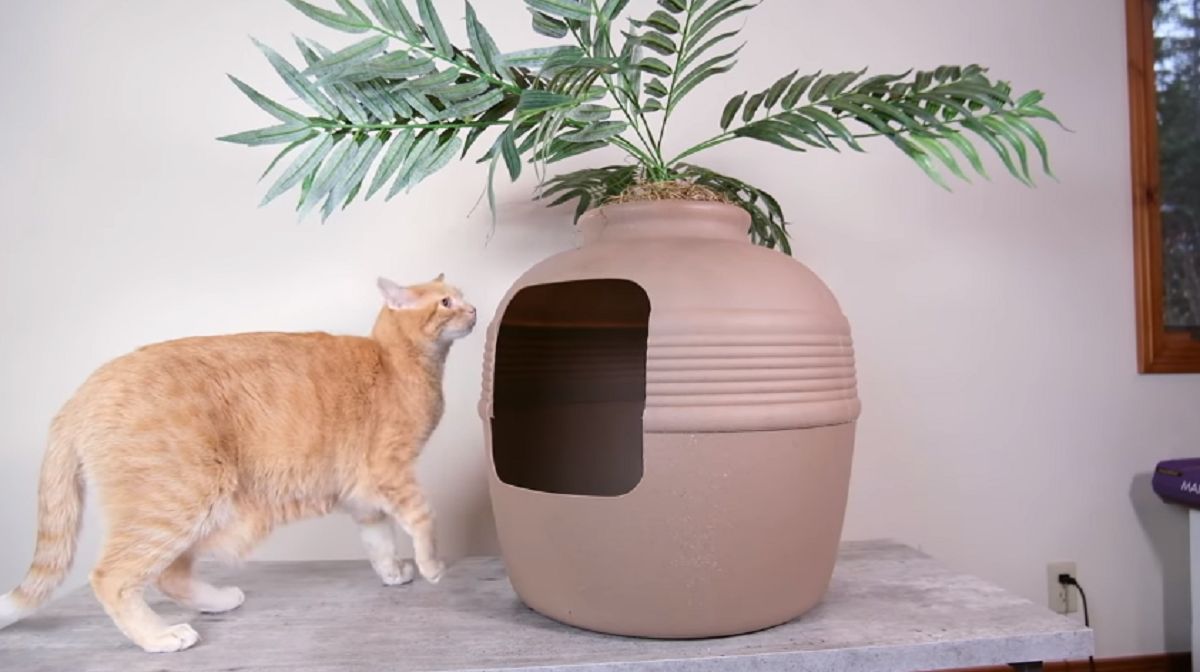
Litter box furniture discreetly blends into your home, providing a stylish alternative to traditional litter boxes. Mallory Crusta / Cats.com
While not a type of litter box, per se, litter box furniture is worth a mention.
These cleverly designed enclosures resemble traditional furniture, like benches or end tables, which lets you seamlessly integrate a litter box into your home.
Advantages
- Discreet design: Litter box furniture blends into your living space, offering an aesthetic alternative to standard litter boxes.
- Maximizes space: Ideal for smaller homes where the litter box must be integrated into main living areas.
- Dual purpose: Not only do these pieces hide unsightly litter, but they also double as functional furniture. (Though, we recommend against placing anything heavy or breakable on top).
Drawbacks to consider
- Pricey: Litter box furniture can be expensive.
- Cats may resist use: Some cats will hesitate to use an enclosed box.
Litter box furniture is best suited for:
- Homes where litter is visible: Litter box furniture helps maintain your home’s aesthetic when the litter box is in a frequently used area.
Types of Litter Boxes Compared
| Litter Box Type | Average Cost | Pros | Cons |
| Open litter pan | $36.76 | Affordable, simple to use & clean | Can be messy, ineffective odor control |
| High-sided box | $27.91 | Contains litter scatter and urine spray | Hard for some cats to jump into (i.e. seniors, small kittens, arthritic cats) |
| Low-entry box | 32.88 | Easy access for kittens and seniors | More litter scatter & mess |
| Sifting litter box | $29.52 | Faster & easier to dispose of waste | Can be heavy, difficult to deep clean, and works best with specific types of litter |
| Covered litter box | $63.05 | Contains mess and odors | Limits cat’s visibility, can be stinky inside |
| Top-entry litter box | $52.14 | Contains mess and odors | Limits cat’s visibility, stinky inside, can be hard for some cats to jump into |
| Corner litter box | $72.68 | Fits snugly in a compact space | Smaller, only one entry point |
| Automatic litter box | $545.43 | Does the scooping for you, maintains a cleaner home | Expensive, bulky, can malfunction |
| Disposable litter box | $21.38 | Simplifies cleanup, great for travel or temporary use | Less durable, needs frequent replacement |
| Travel litter box | $30.36 | Portable design | Smaller than traditional litter boxes |
| Litter box furniture | $247.28 | Hides litter, aesthetic, multi-functional | Expensive, some cats won’t like being covered |



